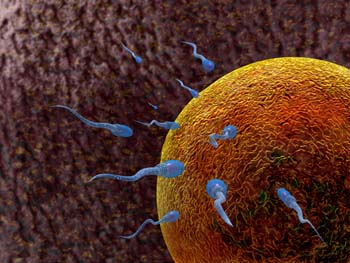(...continued from Part 1.) Hormonal contraceptives work via four steps. Each subsequent step is a back-up of the prior steps, i.e., if the first step fails, the second step comes into play, if they both fail, then the third step is utilized, etc. Here are the steps.
Step One. Prevent ovulation. This is pretty simple. If the ovaries don't release an egg, obviously, there can be no conception.
Step Two. Hinder sperm movement. Hormonal contraceptives thicken cervical mucus, impeding the sperm's movement towards the egg. So even if step one fails and an egg is released, the sperm can't get to it, so no conception.
Step Three. Prevent function of fallopian cillia. Told you I was gonna get sciency. Now, here's where things get a little dicey. Let's say step one fails and an egg gets released, then step two fails and a sperm meets the egg. It is my personal belief that conception occurs when the two join to form a new individual, with complete DNA. (To maintain neutral language, I will not be referring to the joined ovum and sperm as a "baby", but as a "blastocyst". Substitute as you please based on your beliefs of the subject.) Now, step three of hormonal contraception works by stopping the cillia (little hairs) that move the blastocyst down the fallopian tube to the uterus. The blastocyst subsequently starves for lack of nutrition in the fallopian tube, and is expelled during the following menstrual cycle, with the woman never knowing the difference.
Step Four. Preventing implantation. Perhaps the cillia aren't completely stopped. Maybe the blastocyst reaches the uterus. If that occurs, however, it's highly unlikely that it will be able to implant, as hormonal birth control severely thins the endometrium (uterine lining). (This is also how birth control pills promise "lighter periods". The endometrium that is shed each month is thinner.) This step means that the blastocyst cannot attach to the uterine wall, and will be shed along with the endometrium during the next menstrual cycle. Again, without the woman ever knowing any different.
See my concern? No doctor ever told me this. I had to stumble across this information on my own, reading the attached pamphlet that comes with my pills. (And how many people read all the way through those, honestly.) As a Christian, I don't know how I feel about using hormonal contraceptives now. If you've been reading the blog, you know that I'm politically pro-choice, but I've already made my personal choice, and that is that I would never want to have any type of abortion. A nd it's scary to think that maybe I have, without my even knowing.
So here's my proposal, to all the gynecological scientists I'm sure are reading this. Make a pill for men. Just come up with some sort of hormonal way to make a guy shoot blanks for as long as he's on the medicine. You can do that, right? You've come up with a thousand different ways for a woman to prevent a pregnancy. Let the boys have a turn for a while.


No comments:
Post a Comment